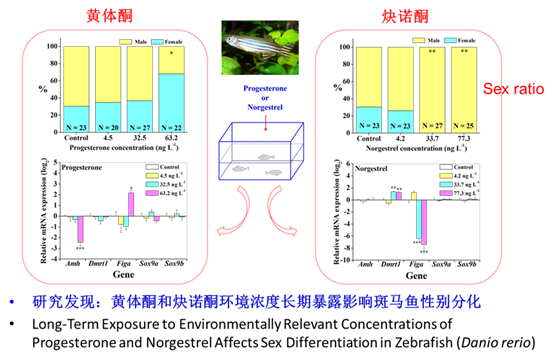Municipal wastewaters have been known to contain various estrogens and androgens. Little is known about the joint action of these chemicals from wastewaters on fishes in the aquatic environment. We also investigated the estrogenic and/or androgenic effects in wild mosquitofish (Gambusia affinis) of two effluent-impacted rivers in South China by determining morphological changes and hepatic mRNA expression levels of relevant genes such as vitellogenin (Vtg), estrogen receptor (ERα) and androgen receptors (ARα and ARβ), and to assess the linkages of those morphological changes and hepatic mRNA expression levels to the chemical concentrations measured by in vitro bioassays and chemical analysis. The results showed a significant induction of Vtg and ERα mRNA in the livers of the males and a gonopodium-like anal fin in the females collected at the majority of sites. Redundancy analysis and Pearson correlation analysis showed that the chemical concentrations obtained by in vitro bioassays and chemical analysis had significant correlations with some of the endpoints for the estrogenic and/or androgenic effects in mosquitofish. The findings from this study indicate that the estrogens and androgens present in the two rivers could cause the observed estrogenic and androgenic effects in mosquitofish.
Natural progesterone and various synthetic progestins are widely used by humans and animals for various purposes, such as human contraception and therapy, animal breeding control and growth promotion. After natural excretion or administration of drugs, these progestogens will be released to the receiving environments. This may cause adverse effects on the organisms in the aquatic environment. The research team led by professor Guang-Guo Ying conducted various investigations into contamination of progestogens in piggery environments, and found eleven progestogens including progesterone (P4) and its derivatives, and synthetic drugs such as dydrogesterone (DGT), medroxyprogesterone acetate (MPA), and norgestrel (NGT) with their concentrations up to 9330 ng/L in wastewater and 1350 ng/g dw in feces. In addition to their detection in animal wastewater and feces, they were also found in the receiving water and soil. In order to reduce these contaminants in animal wastewater, the research team also found the lagoon and digester systems were effective in the removal of progestagens, and should be promoted in developing countries with concentrated animal production. Moreover, biogas digesters and fish ponds should also be encouraged as they are low-cost and eco-friendly and at the same time with economic benefits from energy generated and fish produced.
Laboratory toxicity testing with zebrafish showed that long-term exposure to environmentally relevant concentrations (<100 ng/L) of progesterone and norgestrel affects sex differentiation in zebrafish (Danio rerio). P4 and NGT were demonstrated to significantly induce more females and more males, respectively, which were accompanied with the regulation of the transcriptional levels of several genes (i.e., Amh, Dmrt1 and Figa) related to sex differentiation. In addition, the balance of estrogens and androgens in fish might be altered following exposure to the two chemicals. Meanwhile, P4 and NGT could mainly mediate the transcriptional expression of steroidogenic genes. The modulating hormones and genes associated with steroid synthesis could contribute to disruption of sex differentiation in zebrafish.

Figure 7. Progestogens affect sex differentiation in zebrafish.
References:
(1) Huang GY, Liu YS, Chen XW, Liang YQ, Liu SS, Yang YY, Hu LX, Shi WJ, Tian F, Zhao JL, Chen J, Ying GG (2016) Feminization and masculinization of western mosquitofish (Gambusia affinis) observed in rivers impacted by municipal wastewaters. Scientific Reports. Doi:10.1038/srep20884.
(2) Liu SS, Ying GG, Liu YS, Yang YY, He LY, Chen J, Liu WR, Zhao JL (2015) Occurrence and removal of progestagens in two representative swine farms: Effectiveness of lagoon and digester treatment. Water Research 77, 146-154.
(3) Liang YQ, Huang GY, Liu SS, Zhao JL, Yang YY, Chen XW, Tian F, Jiang YX, Ying GG (2015) Long-term exposure to environmentally relevant concentrations of progesterone and norgestrel affects sex differentiation in zebrafish (Danio rerio). Aquatic Toxicology 160, 172-179.
(4) Liang YQ, Huang GY, Ying GG, Liu SS, Jiang YX, Liu S (2015) Progesterone and norgestrel alter transcriptional expression of genes along the hypothalamic-pituitary-thyroid axis in zebrafish embryos-larvae. Comparative Biochemistry and Physiology Part C: Toxicology & Pharmacology 167, 101–107.
(5) Liang YQ, Huang GY, Ying GG, Liu SS, Jiang YX, Liu S, Peng FJ (2015) A time-course transcriptional kinetics of the hypothalamic-pituitary-gonadal and hypothalamic-pituitary-adrenal axes in zebrafish eleutheroembryos after exposure to norgestrel. Environmental Toxicology and Chemistry 34, 112–119.
(6) Xie YP, Fang ZQ, Hou LP, Ying GG (2010) Altered development and reproduction in western mosquitofish (Gambusia affinis) found in the Hanxi River, southern China. Environmental Toxicology and Chemistry 29, 2607-2615.